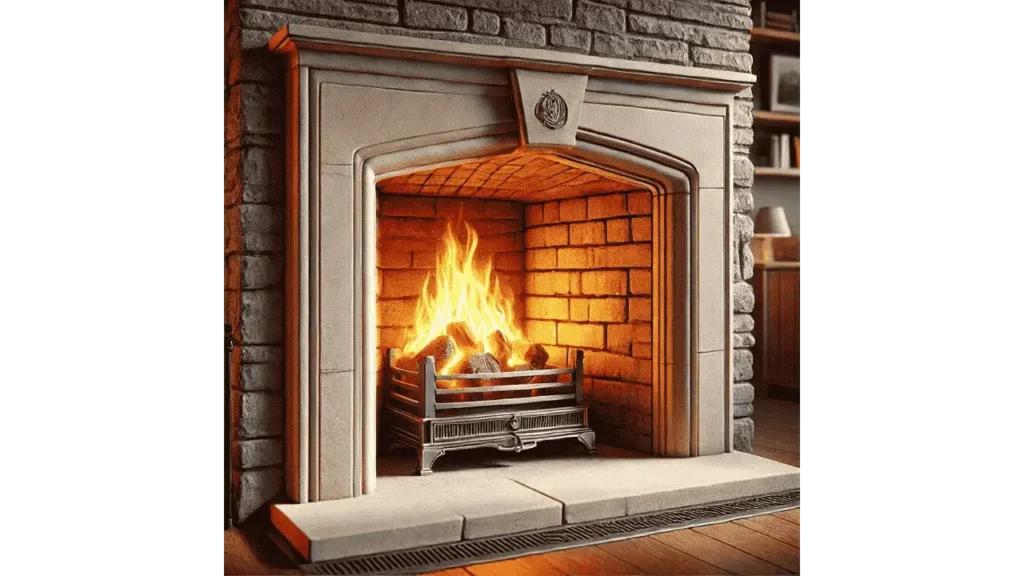A fireplace firebox is the heart of any fireplace, where the fire burns and generates heat for your home. Whether you’re using a traditional wood-burning firebox, a gas fireplace, or an electric insert, proper maintenance is essential to ensure the safety, efficiency, and longevity of your fireplace. Regular upkeep not only keeps your fireplace functioning properly but also helps prevent potential hazards such as poor combustion, smoke buildup, or fire risks.
In this guide, we’ll provide valuable maintenance tips for keeping your fireplace firebox in top condition, from removing buildup to ensuring safety with alarms and regular testing. These simple steps will help you enjoy a safe, warm, and efficient fire every time you light your fireplace.

What Is a Fireplace Firebox? What You Should Know
The firebox is the central part of a fireplace where the fire burns. It is typically constructed with heat-resistant materials, such as firebrick or steel, to contain the flames and prevent damage to the surrounding area. The firebox is essential for ensuring that a fire is contained safely while maximizing the heat output to warm a room. The design, size, and materials used in a firebox can significantly affect the efficiency and safety of a fireplace. Depending on the type of fireplace, the firebox may vary in shape and construction. Understanding the different types of fireboxes can help you make informed decisions about your fireplace installation and maintenance.
Types of Fireboxes
Wood-Burning Fireplace Firebox
A wood-burning fireplace firebox is the traditional type of firebox, often made from firebrick to withstand the intense heat of burning wood. These fireboxes are designed to hold logs, which are burned to create heat and ambiance. The firebox is generally surrounded by a chimney and a flue that directs the smoke and gases out of the home. Wood-burning fireboxes require regular cleaning and maintenance to ensure proper airflow and to prevent the buildup of creosote, a flammable substance that can accumulate in the chimney and lead to fires. They are ideal for those who enjoy the crackling sound of burning wood and the nostalgic ambiance it creates, though they require more effort for fuel and cleanup compared to other types.
Electric Fireplace Firebox
An electric fireplace firebox is an increasingly popular option for those looking for the aesthetic and warmth of a fireplace without the need for fuel, venting, or a chimney. This type of firebox uses electricity to generate heat, and many models feature realistic flame effects created by LED lighting and mirrors. Electric fireboxes can be installed in a variety of locations, as they don’t require any venting or flue system. They are low maintenance, as they don’t produce soot or require wood storage, making them perfect for apartments or homes without existing fireplaces. However, they may not provide the same level of heat or ambiance as traditional wood-burning or gas fireplaces.
Gas Fireplace Firebox
A gas fireplace firebox uses either natural gas or propane to produce a fire, offering convenience and ease of use. Gas fireboxes are typically equipped with ceramic logs or glass media that mimic the appearance of a wood-burning fire. They are a great option for those who want the ambiance of a real fire without the hassle of chopping wood or dealing with ash. Gas fireplaces are efficient, easy to control, and often come with a remote control or wall switch for ignition and temperature regulation. They require regular maintenance, such as checking the burner and ensuring the venting system is functioning correctly, but they are generally more convenient and cleaner than wood-burning fireplaces.
Read More: How to Insulate a Fireplace?
Fireplace Firebox Maintenance Tips
Proper maintenance of your fireplace firebox is crucial for ensuring its safety, efficiency, and longevity. Regular care can prevent common issues such as poor combustion, excess smoke, or even fire hazards. Here are some essential tips for maintaining your fireplace firebox:
Regularly Remove Buildup
One of the most important aspects of firebox maintenance is regularly removing buildup, such as ash, soot, and creosote. After each use, make sure to clean out the ash from the firebox to ensure proper airflow for the next fire. For wood-burning fireplaces, creosote can build up along the walls of the firebox and chimney, creating a fire hazard. A professional chimney sweep should inspect and clean the chimney at least once a year to remove creosote deposits. For gas and electric fireboxes, check for any dust or debris that may have accumulated, as these can interfere with the functionality and heat output of the fireplace.
Install Alarms
To enhance safety, it’s essential to install carbon monoxide (CO) detectors and smoke alarms near your fireplace. Since carbon monoxide is colorless and odorless, a CO detector is particularly important for gas and wood-burning fireboxes. The detectors will alert you to dangerous levels of CO before they become a threat. Smoke alarms should be placed in rooms adjacent to the fireplace to provide an early warning in case of a fire. Regularly test the alarms and change the batteries to ensure they are in good working condition.
Buy Fireplace Insert
A fireplace insert can be a great addition to improve the efficiency of your firebox. Fireplace inserts are sealed units that fit inside an existing open firebox, allowing for better heat retention and more controlled combustion. They are available for both wood-burning and gas fireplaces. Wood-burning inserts often have airtight doors and efficient burn technology, which reduces heat loss and increases the warmth generated. Gas fireplace inserts can offer improved aesthetics and greater control over flame height and temperature. Installing a fireplace insert can help reduce maintenance requirements while enhancing the overall performance of your fireplace.
Test Before Using
Before lighting a fire in your fireplace, always conduct a thorough test to ensure everything is in working order. For wood-burning fireboxes, check the chimney flue to ensure it opens and closes properly, allowing smoke and gases to exit your home. For gas fireboxes, inspect the gas lines for leaks, and test the ignition system to ensure the flames are functioning correctly. If you have an electric firebox, verify that the electrical connections are secure, and test the heat settings to ensure they operate as expected. Always perform these checks before using the fireplace each season to avoid potential issues that could affect safety or performance.
Conclusion
Maintaining your fireplace firebox is crucial for ensuring both safety and efficiency in your home. Regular cleaning to remove buildup, installing alarms for early detection of carbon monoxide and smoke, and using a fireplace insert to enhance performance can all contribute to a better and safer fireplace experience. Testing your fireplace before each use helps prevent potential issues, ensuring that everything operates correctly. By following these maintenance tips, you can enjoy the warmth and ambiance of your fireplace while minimizing the risks associated with fire hazards and inefficient combustion. A little care and attention to your firebox will keep your fireplace running smoothly for years to come, providing comfort and safety to your home.
- How to Build an Electric Fireplace Wall? - June 4, 2025
- How to Clean an Electric Fireplace? - June 3, 2025
- How to Fix an Electric Fireplace? - June 2, 2025

